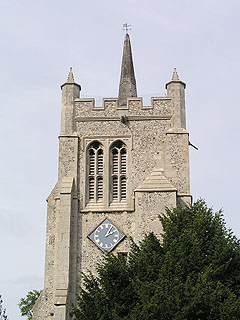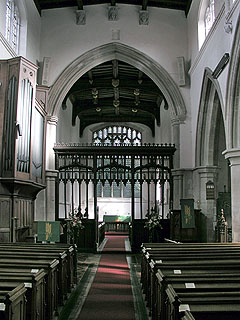From the outside, at least, this is a very exciting building. It started life in the 13th century, but most of what we see now is the result of a big 16th century renovation. The overwhelming impression is of the Perpendicular period triumphant: this is a big church with all the confidence of the wool churches of Suffolk and Norfolk. The west tower is magnificent; it rises from a chequered base-course and is topped by an bell-stage with elaborate square bell-openings. The cross-buttresses sit somewhat back from the corner, turning into little octagonal pepper-pots above the battlements, and a funny little spirelet tops it all off. There's a rather solid stair turret on the south face, with the result that the bell-opening on that side is not central, but if anything that only adds to the pleasant complication of the surfaces. The tower was built right on the cusp of the 15th and 16th centuries, though there is evidence that it used an older base (inside, for example, the tower arch is 13th century, though it sits on 16th century jambs). The rest of the exterior has a restored sort of look, but it is very grand - it even has a two-storey porch (rebuilt in the 19th century) with a little stair turret, something you don't often see in this part of the world.
Unfortunately, the inside feels even more over-cleansed; it is big, but a bit characterless. This is a shame, since there are several interesting features. The first thing I noted was the idiosyncratic font, set to the left of the door. It was made in the 12th century, a typical square Norman affair. Later, it was recut as an octagon and given trefoils on four of its faces; the old Norman arcading survives on the eastern face.
All Saints' also has a very grand rood screen, from the beginning of the 16th century. It has unusually broad, shallow arches - decidedly the most Tudor screen I've seen. I wasn't sure that I liked it, mainly because I found the tracery rather monotonous. I did like the tie-beam roof, though. It dates from the same period, though the angels that it sits on are Victorian. The guidebook suggests that it was erected at the expense of the famous Bishop Alcock of Ely, who founded Jesus College in Cambridge and is buried in a magnificent chantry in Ely Cathedral. His rebus - a cock standing on a globe - can apparently be seen carved on one of the tie-beams, though I couldn't see it.
In the chancel a few of the original 13th century lancets survive, but my eyes were inevitably drawn to the huge east window, another result of the late-Perpendicular refashioning. It's big, but (I know I'm repeating myself) a bit bland. Much more interesting is the south transept. This is now used as a lady chapel, but was once the chapel for the Guild of St Wyburgh. It has quite an elaborate east window from the mid-14th century which is flanked by two very elaborate niches, one for St Wyburgh herself and one for the Virgin. They are, sadly, rather mutilated, but they have a lot of character - they must have been glorious when they were crispy carved and painted in bright colours. Maybe that's why I found All Saints' a bit disappointing: so scrubbed are the rood screen, the roof and these niches, they only serve as a reminder of how much colour we have lost. Maybe the good people of Melbourn should consider repainting them...
All Saints' was open when we visited.


